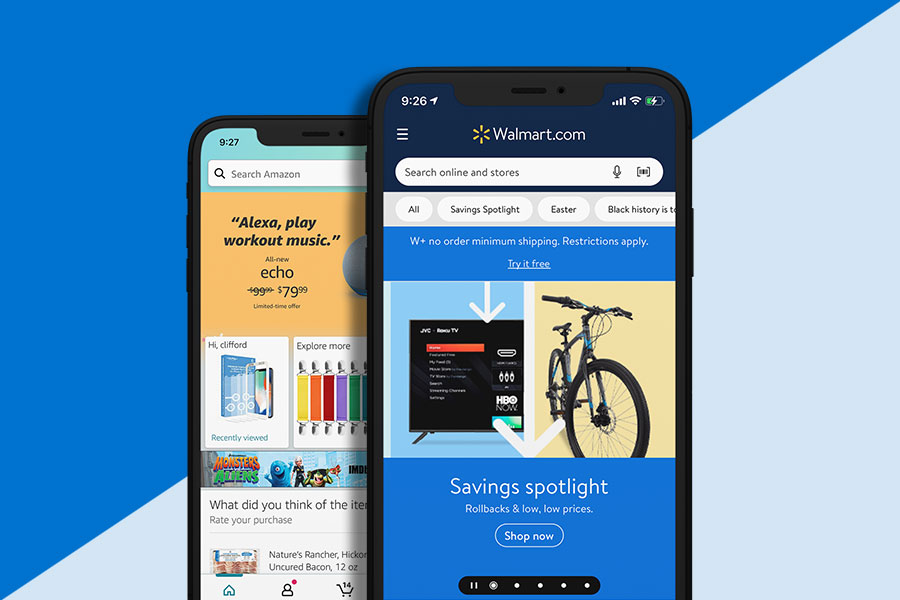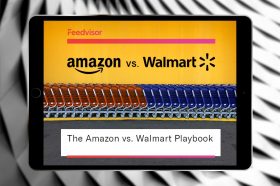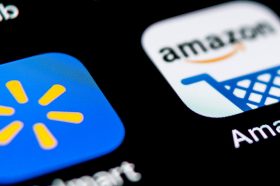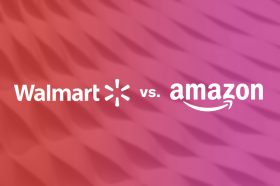Resources - Blog
Is Walmart Catching Up to Amazon?

Stay on top of the latest e-commerce and marketplace trends.
Walmart is continuously rolling out new features in an effort to dethrone Amazon and become the leader in e-commerce. While Walmart dominates brick-and-mortar retail, Amazon reigns supreme in e-commerce. Nevertheless, Walmart’s initiatives are yielding positive results. In 2020, Walmart displaced eBay as the No. 2 online player in the U.S., according to eMarketer.
The biggest advantage Walmart has over Amazon is its physical footprint. Although consumer behavior has shifted towards online shopping, Walmart is leveraging many of its U.S. stores as fulfillment centers for orders from its digital marketplace (apart from its 150+ U.S. warehouses).
Considering that 90% of Americans live within a 10-mile radius of a Walmart brick-and-mortar, the company may deliver items from each of its 4,789 stores in the future. Walmart’s logistics network allows it to provide frictionless shipping, at a fraction of the cost.
In addition to developing an effective shipping ecosystem, Walmart’s plan to beat Amazon includes establishing more partnerships, subscription perks, advertising capabilities, and grocery delivery features. Will Walmart’s strategy help it become superior to Amazon?
Below you will learn how the retail giants stack up per category and if you should consider selling on Walmart vs. Amazon.
Partnerships
Walmart partnered with Shopify in 2020 to expand the number of third-party (3P) sellers on its online marketplace. The deal brought in 1,200 new 3P sellers on the platform, which are made up of small and medium-sized businesses (SMBs). The SMBs benefit from the exposure of being in front of Walmart’s audience while Walmart was able to diversify its online catalog, on top of increasing its sellers.
The retailer also partnered with ThredUp last year to enter the thrifting market. Walmart provides shoppers a selection of nearly 750,000 pre-owned items throughout a variety of categories, such as women’s and children’s clothing, footwear, accessories, and more. Walmart’s ThredUp partnership enabled the company to tap into a different customer base and ThredUp was able to scale its digital reach.
Even though Amazon offers a wide-range of services and products (over 350 million products on its marketplace), it also finds value in partnerships. Amazon developed a partnership with Goldman Sachs in 2020. The e-commerce giant and investment bank worked together to provide small business loans, with a credit limit of up to $1 million, for U.S. Amazon sellers. The collaboration is a win-win as brands selling on Amazon may require additional funding and Goldman Sachs can fulfill their business needs.
Amazon also partnered with Oscar de la Renta in the launch of Luxury Stores last year. Luxury Stores is Amazon’s latest venture into the luxury market and Oscar de la Renta was the first label to be featured in the elevated shopping experience.
Luxury Stores is invite-only, but shoppers are able to request access. The move enabled Amazon to expand its audience to include consumers who purchase designer items and Oscar de la Renta is able to reach its customers who regularly shop on Amazon’s marketplace.
Subscriptions
Walmart launched Walmart+ in 2020 to better compete with Amazon’s subscription service, Amazon Prime. Walmart+ offers free shipping, including next-day and two-day delivery on select products. Free same-day delivery requires a $35 minimum spend.
In addition to free shipping, subscribers also gain access to Walmart’s Scan & Go mobile app and fuel discounts. Although there are only two membership perks, the retailer stated it would release more in the future. Walmart charges users $98 per year or $12.95 per month to use its subscription service.
Amazon Prime offers free next-day and two-day delivery on all eligible items. Amazon’s subscription service also has a $35 minimum threshold for free same-day delivery. Amazon Prime offers its members a long list of perks, which include Amazon Pharmacy, Key by Amazon In-Garage Delivery, Prime Video, Amazon Music Prime, Prime Gaming, Amazon Photos, Prime Reading, Prime Wardrobe, Prime Day, and more.
Amazon Prime is priced at $119 per year or users can opt for the $12.99 monthly plan. Students and individuals who receive government assistance are charged a lower monthly rate of $6.49 and $5.99.
Advertising
Walmart renamed its advertising business Walmart Connect and is building out new features this year. The move is intended to help Walmart Connect be more comparable to Amazon’s advertising service and become one of the top 10 U.S. advertising platforms within the next five years.
The type of advertising features Walmart is developing include greater offerings across its digital channels, enhanced in-store experiences, and offsite advertising opportunities. Walmart is partnering with The Trade Desk to create its own demand-side platform (DSP), which will rival Amazon’s DSP.
Amazon’s advertising service, Amazon Advertising, is used by many sellers on its marketplace. Since the majority (89%) of U.S. consumers are more likely to purchase products from Amazon than other e-marketplaces, Amazon’s advertising features are highly desired by sellers.
Amazon Advertising has a large suite of advertising solutions, which include Sponsored Products, Sponsored Brands, Sponsored Display, Amazon DSP, and many more. Amazon DSP enables brands to reach their customers outside of Amazon’s marketplace by having a digital presence where their target audience is currently shopping.
Grocery Delivery
The pandemic has accelerated the adoption of grocery deliveries. Walmart is the largest U.S. grocer and offers shoppers pick up and grocery delivery services. Walmart currently offers same-day grocery deliveries from 3,000 U.S. stores.
Walmart was able to scale its grocery delivery service by working with Instacart, known to reach 80% of American households. The partnership with Instacart was announced on the heels of the Walmart+ launch. Consumers who are enrolled in Walmart+ are able to receive free same-day grocery deliveries with a $35 minimum spend.
Amazon has developed grocery delivery services that cater to different consumer needs. Consumers who are not enrolled in Amazon Prime can shop for pantry goods on Amazon’s main marketplace. Amazon Prime members are able to access Amazon Fresh and Prime Now at no additional cost.
Amazon Fresh offers an extensive grocery selection and shoppers can schedule deliveries for same-day or a few days ahead of the order date. Prime Now provides consumers groceries from local stores, including Whole Foods Market, and one- to two-hour grocery deliveries. Two-hour grocery deliveries are free with a $35 purchase and one-hour deliveries require a fee of $4.99.
Our Verdict
Walmart has shown tremendous growth in e-commerce in its attempts to catch up to Amazon. Walmart has developed an efficient shipping system, established fruitful partnerships, launched a new subscription program, is building out its advertising features, and expanded its grocery delivery services.
While Amazon’s e-commerce competitors are in an ongoing battle to beat the retailer, Walmart has come close as it has the second-highest market share in the space.
Will Walmart dethrone Amazon in e-commerce? Although Walmart has substantially improved its digital offerings, it is not likely that it will take Amazon’s spot as the leader in e-commerce. Amazon is superior to Walmart in every category mentioned, with the exception of Walmart having a greater physical footprint.
If you are debating selling on Walmart Marketplace vs. Amazon Marketplace, consider both retailers’ audience size and services. We recommend selling on Amazon and expanding your online presence on Walmart’s marketplace (if feasible) to maximize your reach.
Learn what Feedvisor can do for your business.
When you partner with Feedvisor, you automatically receive access to our true, AI-driven technology and hands-on team of e-commerce experts. Contact one of our team members today to learn more about our end-to-end solution for brands and large sellers on Amazon, Walmart, and e-marketplaces.




